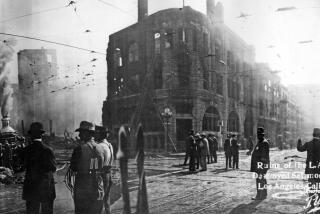Here are our own Fake News Awards, for the fakest news there ever was, starring ... us!
News: It’s the first rough draft of history.
Sometimes very, very rough.
On Wednesday, President Trump posted a link to a series of Fake News Awards, pointing out various errors, missteps and purported mischaracterizations in the media’s coverage of his administration. (The link was broken, but in a cached version of the page, honorees included CNN, the New York Times and several other traditional news outlets.)
But if there have been moments when journalists have flubbed stories over the last year, they still don’t hold a candle to our own Fake News Awards winners, who in the 20th century put out some the fakest news there ever was.
The Battle for L.A. — Los Angeles Times, 1942
On Feb. 25, 1942, The Times reported that war-jittery Los Angeles had been attacked by Japanese pilots. “Roaring out of a brilliant moonlit western sky, foreign aircraft flying both large formations and singly flew over Southern California early today and drew heavy barrages of antiaircraft fire — the first ever to sound over United States continental soil against an enemy invader,” The Times reported. One of the aircraft was reportedly shot down near 185th Street and Vermont Avenue, the story said.
Except that didn’t happen. The military certainly fired antiaircraft batteries into the sky — but not at Japanese pilots. “Exultation turned to embarrassment the next day when the Secretary of the Navy said there had been no air raid,” Times columnist Jack Smith wrote in a 1992 retrospective titled, “Stunning Acts of Bravery That Will Live On in Infamy.” “No enemy planes. It was just a case of jitters.”
The next day — in a front-page editorial headlined “Information, Please” — The Times’ editorial board laid the fault at the feet of military officials who had hyped an attack. “It seems to The Times that more specific public information should be forthcoming from government sources on the subject, if only to clarify their own so-far conflicting statements about it,” the editors wrote.
The mistake did not happen in a vacuum. At the time, local residents were calling for other California residents of Japanese ancestry to be rounded up and sent out of the area, as they eventually were by the U.S. government as part of its mass detention of Japanese Americans. Some were even arrested on the night of the attack — for allegedly aiding the Japanese fliers who didn’t exist. At the time, The Times lauded the mass detention of Japanese Americans, arguing that they would undermine national security during World War II. It was a position the paper’s editorial board, 75 years later, called “shameful” and racist.
‘Jimmy’s World’ — Washington Post, 1980
On Sept. 28, 1980, an up-and-coming young Washington Post reporter named Janet Cooke published a story titled, “Jimmy’s World,” about an 8-year-old heroin addict living in the nation’s capital.
The boy’s plight symbolized America’s struggles with drug addiction. “The paper had no sooner reached the streets than the Washington Post’s telephone switchboard lit up like a space launch control room,” the paper recounted later. “Readers were outraged. The story was described as racist and criminal. The concern was for Jimmy. ‘What about the boy?’ was the central question.”
Police launched a citywide search for Jimmy. Mayor Marion Barry got involved. The boy couldn’t be found. Cooke’s editors had given her permission to protect the identity of Jimmy’s family. Reward money was offered for Jimmy’s location. The story was instantly a contender for a Pulitzer Prize, which it won the next year.
But after the award was announced, Cooke’s old newspaper, the Toledo Blade, noticed that her Pulitzer biography contained false information about her background. The Washington Post’s editors immediately went on alert and interrogated Cooke about her background and about the story. She eventually confessed: “There is no Jimmy and no family. It was a fabrication. I did so much work on it, but it’s a composite. I want to give the prize back.”
Cooke lost her Pulitzer, and the Post later recounted the whole affair in a painful, 14,000-word narrative on how the paper’s world-famous editors got conned by a bright young fabulist.
“Janet had written a great piece,” Bob Woodward, then the assistant managing editor for metropolitan news, said in the account. “In a way, both she and the story were almost too good to be true. I had seen her go out on a complicated story, and an hour later turn in a beautifully written piece. This story was so well-written and tied together so well that my alarm bells simply didn’t go off. My skepticism left me. I was personally negligent.”
The catacomb city of the lizard people — Los Angeles Times, 1934
Where do we even start with this one? (Other than to acknowledge that The Times was ... not a very good newspaper back in 1934.)
“Busy Los Angeles, although little realizing it in the hustle and bustle of modern existence, stands above a lost city of catacombs filled with incalculable treasure and imperishable records of a race of humans further advanced intellectually and scientifically than even the highest type of present day peoples,” Times reporter Jean Bosquet wrote in a front-page story headlined, “LIZARD PEOLPE’S CATACOMB CITY HUNTED.” Unfortunately, the headline typo was not even remotely the most embarrassing part about this story.
A local mining engineer, G. Warren Shufelt, claimed that he had X-ray images of a 5,000-year-old “lost city” containing “a maze of catacombs and priceless golden tablets” left behind by a human tribe of “lizzard [sic] people” who used “powerful chemicals” to tunnel beneath downtown Los Angeles. The Times, not pausing to wonder what it was getting into, faithfully reproduced a map of the tunnel system, with arrows pointing at all the gold. It included a cartoonist’s drawing of the Lizard People dressed in assorted Lizard attire.
No reptoids, nor their reptoid city, were ever found. But the story apparently did inspire a 2011 horror movie titled “Underground Lizard People,” which advertised itself as “based on actual eye witness accounts” and featured the unforgettable roles “Lizard Child #1,” “Lizard Child #2” and “Lizard Child #3.”
The many lives of Victor Frisbie — Los Angeles Examiner, 1950s
Once upon a time, a man named Victor Frisbie was one of the most-quoted men in Los Angeles media. The problem was he didn’t actually exist — a bit of journalistic jiggery-pokery that would be an instant firing offense today.
The legend goes that Frisbie was invented on New Year’s Day 1950, by a Los Angeles Examiner reporter, Maury Godchaux, who was tired of interviewing random bystanders at the Rose Bowl parade in Pasadena, an annual staple of L.A. news coverage. And thus Victor Frisbie was born — right on the front page.
Godchaux died a few months later, and the city’s press corps decided to remember him by keeping Frisbie alive in the pages of the city’s newspapers.
The next year, Frisbie reappeared in the Examiner’s coverage of the Rose Bowl, as a Bakersfield native who had missed the entire event. Another year, Frisbie was a Minneapolis mortician holding a dozen red roses. Later, he got promoted to the parade’s reviewing stand, where he watched alongside California Gov. Goodwin Knight. The next time readers saw him, he was a Maryland dentist, then a bowler, then Brig. Sir Victor Frisbie of the Royal Australian Artillery.
By that point, the paper’s city editor warned reporters that “anyone mentioning Frisbie at the parade would be fired on the spot,” columnist Paul Coates wrote in The Times in an homage to “The Little Man Who Wasn’t There.” “So Victor wasn’t at the parade that year. Instead, Victor Frisbie, 34, a wealthy Petaluma chicken rancher, stood first in line at the public sale of Rose Bowl tickets in late December, only to discover after waiting 18 hours to purchase the first pair, that a pickpocket had lifted his wallet.”
When the morning Examiner merged with the Herald-Express in 1962 after 58 years in business, it featured an obituary on its front page, datelined from Bakersfield: “Victor Frisbie, well-known sportsman and traveler, died here today. He was 58.”
And yet Frisbie lived on, at least in homages in the pages of the rival Times by newspaper hacks who remembered. In fact, we can confirm he’s inside The Times as we speak, looking very much alive and well. Hello again, Victor.
Matt Pearce is a national reporter for The Times. Follow him on Twitter at @mattdpearce.
More to Read
Sign up for Essential California
The most important California stories and recommendations in your inbox every morning.
You may occasionally receive promotional content from the Los Angeles Times.











